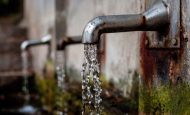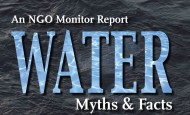UN Recycled Palestinian Water Report
Click Here for NGO Monitor’s Report: “Analysis of Palestinian Water Issues and Israel’s Role”
On September 23, 2021, the Office of the High Commissioner for Human Rights (OHCHR) issued a report on “The allocation of water resources in the Occupied Palestinian Territory, including East Jerusalem” to be presented to the Human Rights Council during the notorious Agenda Item 7 debate. The document, which purports to summarize Israeli government policy on an issue that requires constant Israeli-Palestinian cooperation, contains no official Israeli government information; instead, it is based solely on Palestinian Authority, UN, and NGO sources pushing a Palestinian narrative that politicizes water in order to further the PA’s nationalistic strategic aims.
No official Israeli sources
The UN authors acknowledge that their report is incomplete and one-sided. They claim that the absence of Israeli data and perspectives is due to a lack of engagement from Israeli authorities. However, information submitted by NGO Monitor more than a month prior to UNHRC’s publication was ignored and not included. Notably, NGO Monitor’s submission was based on independent, and largely open-source research – research that the UN clearly did not bother to conduct in violation of credible reporting standards.
NGO Monitor’s submission provided current data on water allocations mandated by the Oslo Accords; information on detailed efforts by Israel to improve Palestinian water infrastructure; and examples of the misuse of water and environmental damage caused by Palestinian non-cooperation and illegal activity.
Conversely, the UN report makes outlandish claims based on weak sourcing. For instance, the assertion that the Israeli town of Ma’ale Adumim enjoys greater access to water than Palestinian communities is based on a caption and an unsourced claim in a 2017 Amnesty International publication.
Similarly, the allegation that Israel’s water carrier, Mekorot, gives Israeli settlements preferential access to water is attributed to other unsourced materials. It does not appear that OHCHR made any effort to contact Mekorot in drafting this document.
Embracing Palestinian politicization of natural resources
A central aspect of the OHCHR report is its politicized and misleading treatment of the Oslo-established Joint Water Committee (JWC).
The Oslo framework established the JWC as the primary bilateral tool for managing water issues. Consisting of equal representation of Israelis and Palestinians, the JWC is responsible for managing the allocation of water and approving all water and sanitation projects in the West Bank.
However, from 2010-2017, the PA boycotted this body, due to its refusal to advance water infrastructure projects that would in any way benefit Israeli settlements. Thus, instead of adhering to the agreement and prioritizing the environment and health – which would entail compromise and working with Israeli officials to jointly manage water planning – the PA politicized the issue (for more on this topic, see here).
Absurdly, OHCHR justifies this approach, amplifying PA complaints that its representatives were expected to approve settlement projects alongside projects serving Palestinian areas. As the JWC is a creation of Oslo, which incorporates the existence of Israeli settlements, this rejection of the JWC is fundamentally a repudiation of the cooperative framework. It should be noted that the Oslo Accords are internationally guaranteed by the UN and thus, OHCHR is undermining the UN and its legal obligations with this publication.
Further advancing this position, OHCHR cites a 2009 World Bank report that decries that, within the JWC, “the PA is forced into positions that compromise its basic policy principles.”
Yet, without any irony, the UN indicates a number of deficiencies with Palestinian water and waste infrastructure, without tracing these back to the decision by the PA to boycott the JWC. These include the claim that “one-third of all water supplied to the Palestinian Authority is lost to leakage due to the poor condition of pipelines and water grids,” and that “25 MCM of untreated sewage from the West Bank is discharged into the environment annually.”
Importantly, the UN document makes no mention of the 2017 decision to confine the JWC to managing Area C projects, affording the Palestinians the opportunity to advance water infrastructure in Areas A and B – where the majority of West Bank Palestinians reside- without receiving JWC approval.
Mischaracterization of Israeli projects
Following the practice of conflating NGO advocacy with credible sources, the report parrots Al Haq, a Palestinian lawfare group that criticized the planned construction of a waste management facility in Jerusalem’s Kidron Valley, stating that “the project has been criticised as intended primarily to benefit settlers by treating their wastewater, and provide them with treated water for irrigation.”
In reality, the project was designed to treat waste for Palestinian communities as well, and to provide wastewater to Palestinian farmers for agricultural use.
Illegal Palestinian drilling
The authors repeat an unsourced claim from a previous UN report asserting that “half of the Palestinian wells in the West Bank have dried up over the last 20 years.”
Unmentioned however is the documented prevalence of illegally drilled wells that negatively impact access to water.
According to 2019 and 2018 Israel Water Authority (IWA) reports, Israel identified nearly 140 instances of illegal well digging by Palestinians in the West Bank.
According to a 2014 paper by Prof. Haim Gvirtzman, an expert in regional water issues, illegal Palestinian well drilling has led to reduced agricultural activity by Israeli farmers in the surrounding Beit She’an and Harod Valleys, as the result of reduced natural water discharge in those areas.
Illegal Palestinian construction
Several of the positions stated in this report stem from a misrepresentation of illegal Palestinian construction in Area C of the West Bank.
For instance, the UN authors describe the higher cost of transporting water to Palestinian communities that are not connected to permanent water infrastructure, as well as claiming that residents of these areas do not have sufficient access to water.
This document, however, erases illegal construction in communities, such as Humsa al Bqaia, Masafer Yatta, and others, that are therefore not connected to local water infrastructure. In other words, the decision to build without planning or permits is the proximate cause of the lack of water infrastructure. As such, primary responsibility for this situation lies with those who chose to establish such communities.
Similarly, the UN’s complaint that Israel had demolished WASH (water, sanitation and hygiene) structures in the West Bank, is directly tied to the issue of illegal building.1
(For more information on illegal Palestinian building in Area C, see NGO Monitor’s “Analysis of Lawyers for Palestinian Human Rights Complaint Regarding JCB.”)
Mekorot’s West Bank extraction
The UN document states that “According to information provided by the State of Palestine, the company continues to operate dozens of wells, trunk lines and reservoirs in area C that abstract [sic] water inside Palestinian territory and provides service instead to the Israeli settlements in the West Bank.”
In contrast, the agreed Oslo framework explicitly provides for extraction of water in the West Bank for Israeli use, providing Israelis in the Jordan Valley, for example, with the opportunity to extract up to 40 MCM/Y from wells.
Moreover, Mekorot itself acknowledges this practice, reiterating in 2015 correspondence with NGO Monitor that it drills in the West Bank to provide water to both Israeli and Palestinian residents of the area.
The UN does not mention that Israel provides water from within the Green Line to Palestinians in the West Bank. According to 2015 correspondence with NGO Monitor, Mekorot noted that in 2015, Israel supplied the West Bank with 114.8 MCM, with 64 MCM being delivered to the Palestinian and 50.8 MCM to Israelis. Of the total 114.8 MCM, 73.7 MCM were transferred to the West Bank from the Israeli national water system.
Israeli use of mountain aquifer
The OHCHR report attempts to frame Israeli water usage in a negative light, complaining of “an extremely inequitable distribution of water, whereby, as estimated in 2014, 87 percent of the mountain aquifer waters were used by Israelis and only 13 percent by Palestinians.”
Firstly, these aquifers do not adhere to the territorial boundaries between Israel and the West Bank, with parts of the aquifers located inside Israel and with rainwater that falls in the West Bank naturally discharging in Israel. Prof. Gvirtzman notes that the areas through which the water is ultimately discharged also represent “geographical and hydrological characteristics of the aquifer.”
According to Gvirtzman, prior to Israel’s 1967 takeover of the West Bank, it utilized 340 MCM/Y in the western basin of the Mountain Aquifer, out of a total of 360 MCM/Y held by the basin. The remaining 20 MCM/Y was used by the local population in the West Bank.
Similarly, during this period, Israel used 115 MCM/Y of the Northern Mountain Aquifer, compared to just 25 MCM/Y used by the Palestinians.
Gaza water infrastructure
When discussing Gaza’s water infrastructure, the UN report barely addresses Palestinian mismanagement and internal tensions – devoting only two sentences to these decisive phenomena.
Under the Oslo Accords, water supply and sewage collection systems in Gaza were transferred to Palestinian control, along with the responsibility for their management, development, and conservation. In the interim agreement signed in 1995 (Oslo II), Israel agreed to transfer an additional 5 MCM/Y to Gaza. Notably, in 2017, Israel and the Palestinian Authority agreed to double the amount of water sold to Gaza to 10 MCM/Y. In September 2021, Israel announced an additional 5 MCM/Y increase.
In 2005, in the context of the part of the departure of Israeli civilians and military from Gaza (“Disengagement”), the water systems of the vacated Israeli communities, including 25 wells, were also transferred to the Palestinians. By the end of the Disengagement process, all water supply and sewerage systems in Gaza were under exclusive Palestinian control. As such, following the 2005 the Hamas government and the Palestinian Authority bear full and sole responsibility for the situation in Gaza.
Notably, a 2018 World Bank report claimed that the Palestinian Authority faced significant challenges in securing external funding for water infrastructure projects due to a lack of clarity in the division of responsibilities between the PA Water authority and local authorities.
However, despite these problems, various water infrastructure projects have progressed in Gaza. According to a 2019 IWA report, a sewage treatment plant was opened in northern Gaza at an investment of approximately $100 million. Additionally, a desalination plant which serves 400,000 people was opened in Gaza City in April 2021. According to the Palestinian Authority, funding has been secured for the construction of an additional desalination plant for Gaza. The project, which has received €70 million in funding from the European Commission, is expected to be completed in 2022.
Gaza conflict and water
OHCHR erases the role of Hamas’ military activities while criticizing Israeli policy towards Gaza, blaming Israeli restrictions on the import of certain dual-use items into Gaza, ignoring Hamas’ theft of these materials, such as pipes, to construct military installations and manufacture arms.
Similarly, it accuses Israel of harming Gaza’s water infrastructure during May 2021 military operations. However, there is no evidence to suggest that Israel intentionally targeted water infrastructure and that the damage caused was anything other the result of legitimate military strikes.
Indeed, like many other UN efforts, this publication presents the alleged effects of Israeli strikes in isolation, ignoring evidence of collateral damage resulting from Hamas co-locating its military installations near civilian infrastructure.
Footnotes
- Notably, the UN’s Office for the Coordination of Humanitarian Affairs (OCHA), cited as a source for information pertaining to demolitions, applies the term “infrastructure structures” broadly to “include water pipes, roads, network facilities, among others,” and uses the term “demolition” to include “dismantlement, confiscation or sealing off of structures or parts of structures.”


